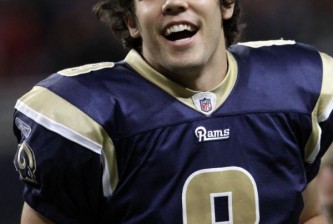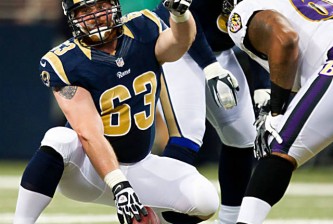
Portrait of a CTE survivor: former Viking Fred McNeill.
Part 1: Tackling the Unknown.
Part 2: The Disease the NFL Wanted to go Away.
Part 3: A Light in the Darkness.
Part 3: Light in the darkess: The NFL’s “88 Plan”
The most impactful change in the NFL’s treatment of the issue didn’t come from a scientific paper — it came from a letter written by the beleaguered wife of Colts Hall of Famer John Mackey. He wore number 88 on the field from 1963 to 1971; but in his years off the field, his life had become “a deteriorating, ugly, caregiver-killing, degenerative, brain-destroying, tragic horror.”
The letter written by Sylvia Lackey was so persuasive that the league agreed in 2007 to dip into the billions of dollars that players and owners are currently fighting over, and help provide for retired players suffering from dementia.
“Since the plan’s inception in 2007,” writes Laskas in GQ, “149 retired players suffering from dementia have been approved to receive benefits.”
149 players sick enough in the head, by the NFL’s own count. And those are the players who have come forward. There are about 16,000 retired players living here and living there, some—like Hall of Famer Rayfield Wright, a Cowboys tackle—too proud to get checked for dementia. There are players’ wives waiting to apply for the plan, unwilling to do so while their husbands are still coherent enough to understand.
Mackey’s pension from the NFL paid $2,450 per month. As anyone knows who has dealt with a family member with Alzheimer’s or Parkinson’s, the costs of caregiving can make those few thousands of dollars seem like pocket change. The 88 Plan provides those who qualify with as much as $88,000 per year.
Now that the NFL has locked out its players, severing all financial ties, are these helpless souls being caught in the cross-fire? Fortunately, the answer is no, according to Jilane Rodgers, who works for the NFL Players (formerly the NFLPA), and who responded to my question via email.
“The NFL for now has extended in full its obligations to the 88 Plan, according to Miki Yaras-Davis, Director of the Player Benefit Trust (a group independent of the NFLPA, which consults on benefits).”
The key words in that statement, though: “for now.” No one can predict what impact a prolonged lockout might have.
The End Zone: Finding a Cure for CTE?
Laskas just published a follow-up story in GQ, a quietly staggering article that focuses on the plight of Fred McNeill, a living example of a life interrupted by CTE.
“There was a time,” Laskas writes, “when Fred was brilliant.” He didn’t see the end of his career with the Vikings as a time to mothball himself. Still in his thirties, McNeill must have felt like he was entering his prime. He went back to school, got a law degree and became partner in a Minnesota law firm. He was a rising star within the firm, until his brain began to short-circuit. He was voted out at age 44.
Now, his short-term memory is almost completely shot, and the speed at which he processes new information lags behind 99% of other adults his age. But McNeill still has moments of lucidity. And he doesn’t blame the NFL for making him sick.
“I mean, did anybody know?” he says, slouched on the couch. “Did the owners know? Did the players? I don’t think you can get angry if no one could have anticipated that this was going to happen. The only thing is, okay, there is a problem now.” He sits forward, brings his hands up parallel, like a trial lawyer moving blocks of logic into sequence.
“You’ve got NFL football, and you’ve got quarterbacks, talented people, making millions of dollars. You’ve got a tough economy, and in a tough economy, sports are still popular. And still generating money. And so the owners are still making… You can imagine! You’re paying your employees millions of dollars. What kind of money are you making? And so how do you then look at something that wasn’t anticipated? Your employees and your former employees are having difficulty living a normal life because of your business. So it’s not looking at the owners and saying you’re bad people. It’s saying: ‘Here’s the situation—now take care of it. You can’t say you can’t afford it.'”
Meanwhile, scientific research into CTE continues to move forward, and the NFL is actively taking part. Just ten days ago, the league and the NFL Alumni Association announced a new neurological care program designed to diagnose and treat possible brain diseases in its former players. Five centers around the country — four corners in Atlanta, New York, San Francisco and Los Angeles, and one here in Saint Louis — will be taking part.
The facility here, at Washington University’s School of Medicine, is appropriately named “The Hope Center.”
For his part, Dr. Omalu has all the pathology results he needs to confirm his diagnosis of CTE, and is moving toward finding a cure.
“You pop a pill before you play, a medicine that prevents the buildup of tau,” he says. “Like you take an aspirin to prevent heart disease.” Why not? “This is how we now need to talk. Not this back-and-forth of human selfishness. Not this NFL politics and meanness. Anybody still denying the disease is out of his mind. The issue now is treatment.”
This is Part 3 of a three-part feature on CTE. But the story doesn’t end here. For related stories, read on:
RamsHerd.com: A rising star, Rams defensive end Chris Long openly ponders whether the game was too violent for kids.
Fox Sports: Like Fred McNeil, former Ram Cam Cleeland is another poster child for the early effects of CTE






















